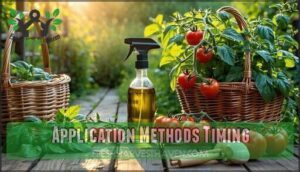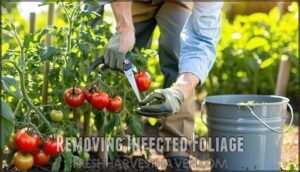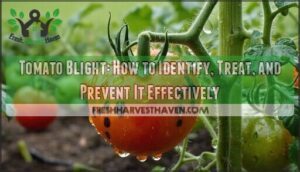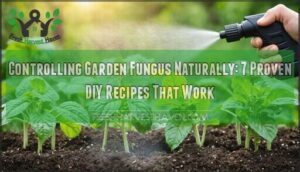This site is supported by our readers. We may earn a commission, at no cost to you, if you purchase through links.
 You can tackle tomato fungus naturally with ingredients from your kitchen.
You can tackle tomato fungus naturally with ingredients from your kitchen.
Mix a tablespoon of baking soda, teaspoon of vegetable oil, and drop of mild soap in a gallon of water for an effective spray.
Apple cider vinegar, garlic, and even aspirin solutions work too.
Apply these treatments early morning or evening to avoid leaf burn.
The key is consistency—reapply every week or after rain.
Proper plant spacing and removing infected leaves help prevent problems before they start.
These simple remedies can save your harvest without harsh chemicals, and there’s a whole toolbox of natural solutions waiting to be discovered, using common ingredients like baking soda, and effective sprays.
Table Of Contents
- Key Takeaways
- Natural Fungicides Overview
- Tomato Fungal Diseases
- Homemade Fungicide Recipes
- Application Methods Timing
- Preventative Plant Care
- Frequently Asked Questions (FAQs)
- How to get rid of fungus on tomato plants naturally?
- What does Epsom salt do for tomato plants?
- What is the best homemade fungicide for tomatoes?
- Should you sprinkle baking soda on tomato plants?
- How do you treat tomato fungus?
- What fungicide should I use on my tomato plant?
- How do you get fungus from a tomato plant?
- How do you prevent tomato blight?
- What fungus infects tomato plants?
- How do you get rid of leaf mold on tomato plants?
- Conclusion
Key Takeaways
- You’ll find effective natural fungicides right in your kitchen—mix baking soda with water and soap, or try garlic spray and apple cider vinegar solutions that work just as well as chemical treatments.
- You must apply these homemade sprays consistently every week or after rain during early morning or evening hours to prevent leaf burn and maximize absorption.
- You can prevent most fungal problems before they start by spacing plants properly for airflow, watering at soil level instead of on leaves, and removing infected foliage immediately.
- You’ll get the best results by combining treatment with prevention methods—use resistant varieties, practice crop rotation, and maintain good garden hygiene to stop fungus from taking hold.
Natural Fungicides Overview
You don’t have to rely on harsh chemical fungicides when your tomato plants develop fungal problems.
Natural alternatives like baking soda, garlic sprays, and apple cider vinegar work just as well and won’t harm beneficial insects or contaminate your harvest, using natural methods.
Baking Soda Solution
Baking soda stands as your first line of defense against tomato fungus. This kitchen staple alters pH levels, creating an environment where fungi can’t thrive—think of it as changing the rules of the game.
Baking soda benefits include disrupting spore development while remaining completely safe for your plants and family. Mix one teaspoon baking soda with one cup water and a few drops of liquid soap for an effective baking soda solution. For more effective control, consider using a natural botanical fungicide.
- Apply baking soda tomato spray weekly during growing season
- Spray during evening hours to prevent leaf burn
- Test solution mixing ratios on small areas first
- Confirm complete coverage for maximum solution effectiveness
This natural tomato fungus treatment works best as preventative measures, applied before disease appears rather than after infection sets in.
Garlic and Hot Peppers Spray
While baking soda offers effective treatment, garlic spray tomato plants provides another powerful natural solution.
This homemade spray combines garlic’s sulfur compounds with capsaicin from hot peppers, creating spray effectiveness against fungal pathogens.
Studies have shown that fungicide treatments can also lead to improved marketable yield.
| Ingredient | Amount |
|---|---|
| Garlic cloves | 4-6 bulbs |
| Hot peppers | 2-3 pods |
| Water | 1 gallon |
Different garlic types and pepper Scoville units affect potency.
Recipe variations include adding soap for better adhesion.
Blend ingredients, strain mixture, then apply these natural treatments weekly.
Application frequency depends on infection severity—spray both leaf surfaces for maximum protection against fungal diseases.
Apple Cider Vinegar Mixture
Apple cider vinegar works wonders as a homemade fungicide for tomatoes.
Its natural acidity disrupts fungal growth through pH restoration on leaf surfaces.
Here’s your action plan:
- Mix 1 tablespoon ACV with 1 gallon water for proper concentration
- Apply during early morning for best leaf application results
- Test on small area first to check plant sensitivity
- Reapply weekly for consistent fungal prevention and soil health benefits
The key to successful application is following these steps carefully and consistently, ensuring the natural acidity of the apple cider vinegar can effectively disrupt fungal growth.
Horseradish and Cornmeal Sprays
Throughout the growing season, horseradish and cornmeal create powerful homemade fungicide tomatoes need.
Horseradish benefits include strong antifungal properties that ward off soil pathogens, while cornmeal spray forms a protective barrier.
Mix one cup cornmeal with water using a 1:4 cornmeal ratio, then strain thoroughly.
Apply this natural remedies tomato fungus solution every two weeks for ideal spray frequency and organic tomato care results.
To further bolster your efforts, consider that baking soda disrupts fungal cell walls.
Tomato Fungal Diseases
You’ll recognize common tomato fungal diseases by their telltale signs—from the flour-like white coating of powdery mildew to the dark, water-soaked lesions of late blight.
Knowing what you’re dealing with helps you choose the right natural treatment and act quickly before the infection spreads to your entire crop.
Powdery Mildew Symptoms
Recognizing powdery mildew starts with Identifying Powdery Mildew on your tomato plants. This sneaky fungal disease creates a white, dusty coating that looks like someone sprinkled flour across your leaves.
Early Stage Symptoms begin as small, circular white spots that gradually expand into larger patches. > Powdery mildew coats tomato leaves like a dusting of flour—spot it early to shield your plants from harm.
Watch for these telltale signs of Disease Progression:
- White, powdery coating on upper leaf surfaces
- Yellow patches developing beneath white spots
- Leaves curling or becoming distorted
- Affected Plant Parts including stems and flower buds.
Environmental Factors like high humidity and poor air circulation create perfect conditions for this fungus. Unlike other diseases, powdery mildew doesn’t need wet leaves to spread. Baking soda solution and milk spray tomato fungus treatments work well for tomato fungus prevention when applied early.
Late Blight and Leaf Mold
Devastation strikes when late blight and leaf mold invade your tomato garden.
You’ll spot late blight’s brown lesions spreading across leaves, stems, and fruits, while leaf mold creates distinctive oily blotches.
These fungal infections thrive in cool, damp conditions, causing rapid leaf decay.
Combat these diseases with natural fungicides like hydrogen peroxide solutions for effective blight control and mold prevention.
Proper spacing and resistant varieties strengthen your fungus management strategy.
Septoria Leaf Spot and Anthracnose
You’ll face two stubborn fungal infections: septoria leaf spot creates light-centered spots with dark edges, while anthracnose leaves blackened fruit spots.
Both spread through water and wind, making disease management critical for healthy tomato care.
Combat these infections with proven organic remedies:
- Remove infected leaves immediately to stop fungal infection spread
- Apply natural fungicides like baking soda solutions weekly
- Spray organic treatments right after rain when spores are active
- Choose resistant varieties that naturally fight tomato plant fungus
- Improve air circulation through proper spacing for effective organic gardening tomatoes
These leaf symptoms won’t disappear overnight, but consistent treatment works.
Blossom End Rot Prevention
Unlike other fungal issues, blossom end rot isn’t actually caused by fungi—it’s a calcium boost deficiency combined with inconsistent water management. You’ll spot dark, sunken spots on tomato bottoms that look like someone pressed a hot coin there.
Blossom end rot looks scary but it’s not fungal—just thirsty tomatoes crying for consistent water and calcium.
| Prevention Method | Key Details |
|---|---|
| Soil pH Management | Maintain 6.2-6.8 for ideal calcium absorption |
| Fertilizer Tips | Avoid high-nitrogen feeds that block calcium uptake |
| Water Management | Keep soil consistently moist, never bone-dry then soaked |
Preventative plant care starts with crop rotation and choosing resistant varieties. Natural fungicides won’t fix this—consistent watering will. Organic gardening tomatoes means understanding that tomato plant health naturally depends more on steady moisture than fancy sprays.
To address this issue, it’s vital to understand calcium deficiency causes and take preventive measures accordingly.
Homemade Fungicide Recipes
You can create powerful antifungal treatments right in your kitchen using common household ingredients that rival commercial fungicides.
These time-tested recipes combine science with simplicity, giving you effective weapons against stubborn tomato diseases without breaking the bank, using common household ingredients.
Copper Sulfate and Hydrated Lime
Why settle for expensive chemicals when copper sulfate and hydrated lime create powerful Bordeaux Recipe solutions?
Mix copper sulfate crystals with calcium hydroxide using the traditional 3:3:50 ratio for effective Fungal Control. This copper fungicide alternative tackles powdery mildew and blight naturally.
Apply during cooler morning hours to prevent leaf damage. Copper Mixtures provide Lime Benefits for long-lasting tomato plant fungus protection through proven Soil Treatment methods.
The use of copper fungicide products is essential for maintaining healthy plants.
Compost Tea Preparation
Prepare quality compost tea by steeping well-aged compost for 24-48 hours in warm water.
This brewing process activates beneficial microorganisms that boost soil health and provide fungal prevention.
Strain thoroughly, then dilute 1:5 before spraying.
This organic fertilizer delivers compost benefits while serving as one of nature’s most effective natural fungicides for ecofriendly gardening.
For ideal results, understanding compost tea properties is essential.
Hydrogen Peroxide Treatment
Hydrogen peroxide creates a powerful organic remedy for tomato plant fungus like leaf spot and early blight.
Mix 8-12 tablespoons of 3% hydrogen peroxide per gallon water for proper peroxide dosage.
This natural fungicide provides excellent fungal control when you spray infected leaves biweekly.
Treatment timing matters—apply during cooler hours to prevent leaf burn while boosting fungus prevention through improved soil health.
Aspirin Solution for Prevention
You’ll find aspirin solution surprisingly effective for fungal prevention in your tomato garden.
This natural remedy boosts plant health by strengthening immunity against common diseases. Simply dissolve two aspirin tablets in two gallons of water for your homemade fungicide.
Apply this preventative measure every two weeks during growing season, spraying leaf surfaces thoroughly. Aspirin benefits include enhanced disease control without harsh chemicals, making it perfect for organic gardening tips.
Time applications for early morning to maximize absorption and protect against tomato plant fungus.
Application Methods Timing
Timing your fungicide application correctly makes the difference between success and wasted effort.
You’ll get the best results when you spray during early morning hours or after sunset, which prevents leaf burn and gives your plants time to absorb the treatment without harsh sunlight interfering.
Spray Application Techniques
Since effective spray application requires precision, you’ll need proper spray nozzles and consistent spray pressure for ideal leaf coverage.
Your homemade sprays like baking soda solution and garlic spray work best with these techniques:
- Choose fine-mist nozzles for even distribution and minimal waste
- Maintain steady pressure to guarantee complete foliage protection
- Target both leaf surfaces where fungi typically develop
- Clean equipment thoroughly before and after each spray application
Selecting the right spray nozzle types is vital for effective fungus treatment.
Early Morning or Evening Sprays
Timing makes all the difference when applying natural fungicides like baking soda solution or garlic spray.
Early morning or evening applications maximize absorption while preventing leaf burn from intense sunlight.
These cooler periods offer ideal spray timing for fungal prevention, allowing proper leaf coverage without stress.
Your homemade sprays work best when temperatures drop below 85°F, ensuring effective neem oil penetration and protection.
Avoiding Leaf Burn and Eye Contact
Proper Spray Safety protects both you and your plants from unnecessary harm. When applying neem oil tomato fungus treatments or other homemade remedies, plant sensitivity requires careful attention to prevent Leaf Damage.
Follow these Burn Prevention guidelines:
- Wear Eye Protection and protective gear during all applications
- Check dilution ratios carefully – stronger isn’t always better
- Apply during cooler evening hours for Gentle Application
Your tomatoes will thank you for this thoughtful approach to leaf burn prevention.
Straining Cornmeal Mixture
After letting your cornmeal mixture sit for 24 hours, you’ll need to strain out the chunky bits that could clog your sprayer.
Use a fine-mesh strainer or cheesecloth for smooth cornmeal strain results. This fungicide prep step guarantees your spray techniques work flawlessly.
The leftover pulp makes excellent compost, so nothing goes to waste. Your natural fungicides will flow smoothly through any nozzle, giving you professional application tips for effective DIY tomato disease control.
By implementing season extension methods, you can enjoy a longer harvest period and maximize your crop yields.
Preventative Plant Care
Prevention beats treatment every time in the case of tomato fungus. You’ll save yourself hours of spraying and worry by setting up your garden correctly from the start.
Spacing Plants for Airflow
Crowded tomato plants create a perfect storm for fungal prevention disasters. Plant spacing isn’t just about aesthetics—it’s your first line of defense against disease.
Strategic air circulation keeps moisture from lingering on leaves, where fungi love to party. Think of proper spacing as giving each plant room to breathe and defend itself naturally.
- Space tomato plants 18-24 inches apart for ideal airflow
- Remove lower branches that touch soil to improve soil aeration
- Use supports like cages or stakes to prevent crowding
- Practice crop rotation yearly to break disease cycles
- Thin overcrowded foliage regularly to boost circulation
By understanding disease prevention strategies, gardeners can better protect their plants from common garden diseases.
Watering and Feeding Plants
Consistently watering your tomatoes at the base prevents leaf moisture that invites fungal problems.
You’ll want to maintain proper soil moisture without creating waterlogged conditions that weaken roots.
| Watering Factor | Best Practice |
|---|---|
| Irrigation Methods | Drip irrigation or soaker hoses |
| Water Quality | Use filtered or rainwater when possible |
| Nutrient Balance | Mix compost tea weekly during growing season |
| Fertilizer Types | Organic compost and fish emulsion |
Focus on plant feeding with natural ingredients like compost to strengthen disease resistance naturally.
Removing Infected Foliage
Beyond watering basics, foliage removal becomes your next line of defense against fungal diseases. Think of infected foliage removal as surgical precision—you’re stopping disease spread before it devastates your crop.
Here’s your plant sanitation game plan:
- Scout daily for septoria leaf spot and early tomato blight symptoms
- Cut infected leaf material with sterilized pruners immediately
- Bag debris instead of composting to prevent reinfection
- Disinfect tools with rubbing alcohol between plants
- Monitor regrowth for signs of lingering fungal control issues
Swift action prevents small problems from becoming garden disasters.
Frequently Asked Questions (FAQs)
How to get rid of fungus on tomato plants naturally?
When fungal problems strike your tomato plants, don’t throw in the towel!
Mix one teaspoon baking soda with water and mild soap, then spray affected leaves in the evening to prevent fungal growth naturally.
What does Epsom salt do for tomato plants?
Epsom salt provides magnesium, which you’ll need for chlorophyll production and photosynthesis.
It helps prevent yellowing leaves and boosts fruit development.
Mix one tablespoon per gallon of water monthly for healthier tomatoes.
What is the best homemade fungicide for tomatoes?
You’ll get excellent results mixing one teaspoon baking soda with water and a few drops of dish soap.
This simple solution disrupts fungal growth effectively and won’t harm your plants when applied properly.
Should you sprinkle baking soda on tomato plants?
Sprinkling straight baking soda absolutely transforms your garden battles.
Don’t sprinkle dry baking soda directly—it’ll harm plants.
Instead, you’ll create a proper solution mixing one teaspoon with water and soap for safe, effective fungal treatment, which is a complete concept in gardening.
How do you treat tomato fungus?
Mix baking soda with water and soap, then spray infected leaves thoroughly.
You’ll also want to remove diseased foliage, improve airflow between plants, and water at soil level to prevent moisture buildup that fungi love.
What fungicide should I use on my tomato plant?
Like a doctor’s prescription customized to each patient, choosing the right fungicide depends on your specific tomato disease.
Use baking soda spray for powdery mildew, neem oil for broader protection, or hydrogen peroxide for leaf spots.
How do you get fungus from a tomato plant?
You’ll remove fungus from tomato plants by applying baking soda spray, neem oil, or hydrogen peroxide solutions.
Remove infected leaves, improve airflow between plants, and water at soil level to prevent moisture on foliage that encourages fungal growth.
How do you prevent tomato blight?
Ironically, while you’re busy nurturing tomatoes, blight’s already lurking. You’ll prevent it by spacing plants properly, watering at soil level, choosing resistant varieties, and ensuring good airflow around your plants.
What fungus infects tomato plants?
Several fungal diseases commonly attack your tomato plants, including powdery mildew, late blight, septoria leaf spot, and anthracnose.
These pathogens thrive in humid conditions and spread through water, wind, or contaminated tools, causing distinctive symptoms on leaves and fruits, particularly anthracnose.
How do you get rid of leaf mold on tomato plants?
When leaf mold crashes your tomato party, you’ll want to spray a baking soda solution (1 teaspoon per cup water with soap drops) in the evening.
Ensuring you coat both leaf surfaces completely.
Conclusion
Research shows that untreated tomato fungus can destroy up to 80% of your harvest—a devastating loss that’ll make any gardener’s heart sink.
Fortunately, treating tomato plant fungus naturally doesn’t require expensive chemicals or complicated procedures. You’ve got everything needed in your kitchen cabinet, from baking soda to garlic.
These remedies work when applied consistently, and they’re safer for your family and environment. Remember, prevention beats cure every time, so start early and stay vigilant throughout the growing season, using natural methods and keeping a close eye on your plants to avoid a devastating loss.
- https://www.thespruce.com/early-blight-on-tomato-plants-1402973
- https://www.seedparade.co.uk/news/pests-and-diseases/identify-prevent-and-treat-common-tomato-diseases/
- https://www.farmstandapp.com/64564/7-homemade-remedies-for-tomato-diseases/
- https://farmonaut.com/precision-farming/organic-powdery-mildew-treatment-protecting-tomato-and-eggplant-leaves-from-fungal-infestation
- https://fifthseasongardening.com/organic-treatments-for-fungal-infections












